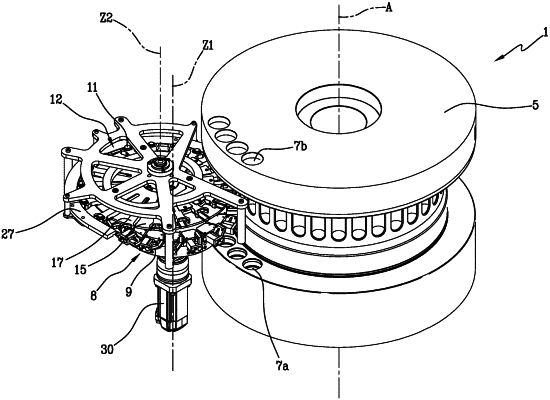| CPC B29C 43/34 (2013.01) [B29C 43/02 (2013.01); B29C 43/50 (2013.01); B29C 2043/3277 (2013.01); B29C 2043/3472 (2013.01); B29C 2043/5084 (2013.01); B29L 2031/7174 (2013.01)] | 16 Claims |

|
1. An apparatus comprising:
at least one mould for forming an object from a dose of polymeric material;
a conveying device having a central support rotatable about a first axis, the conveying device comprising at least one conveying element movable along a first closed path for collecting the dose and subsequently releasing the dose in the at least one mould;
a removing device having a central body rotatable about a second axis, the removing device comprising at least one removing element movable along a second closed path, the at least one removing element being configured to convey the object from the at least one mould towards an outfeed conveyor;
wherein the first axis is distinct from the second axis and at least one point exists at which one path selected from between the first closed path and the second closed path overlaps another path selected from between the second closed path and the first closed path; and
wherein the at least one mould is movable in a movement direction, the at least one conveying element is movable along the first closed path in a first advancement direction, the at least one removing element is movable along the second closed path in a second advancement direction opposite relative to the movement direction, wherein the first advancement direction is opposite relative to the movement direction;
said conveying element being further rotatable about an axis of rotation positioned transversally to the first axis, so as to turn the dose from a first orientation with which the dose is received by the conveying element, to a second orientation with which the dose is released by the conveying element in the mould;
wherein the apparatus further comprises two cams for moving the conveying element between the first orientation and the second orientation, the two cams operating in conjunction with each other so that the conveying element rotates about the axis of rotation while it moves along the first closed path; and
wherein a carriage is associated with the conveying element, the carriage being slidably supported by the central support, said two cams comprising a first cam arranged in a fixed position for moving the carriage away from, or towards, the first axis, said two cams comprising a further cam which is fixed relative to the conveying element, the further cam being caused to oscillate about the axis of rotation by the carriage.
|